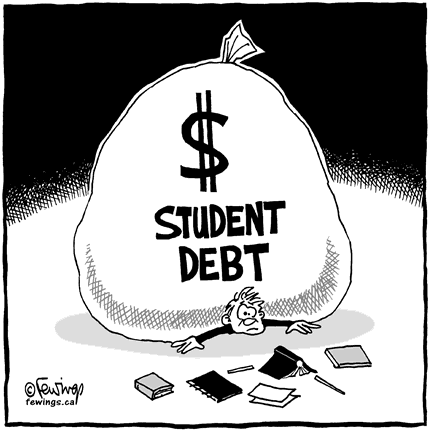The Rising Cost of a Better Future
Aug 22, 2013
 With the summer quickly nearing its end, it is back to school for millions of college students across the country, myself included. This also means many of us will be taking out hefty amounts of student loans. Student loan debt is the second largest debt that consumers carry, as the average college student owes nearly $27,000 in loans upon graduation.
With the summer quickly nearing its end, it is back to school for millions of college students across the country, myself included. This also means many of us will be taking out hefty amounts of student loans. Student loan debt is the second largest debt that consumers carry, as the average college student owes nearly $27,000 in loans upon graduation.
Subsidized Stafford loans, which are government provided and based on financial need, account for about 26% of all federal student loans. Many students and parents may be unaware that on July 1st the interest rate on these subsidized Stafford loans doubled from 3.4% to 6.8%, a rate increase that affected nearly 7.4 million students.
However, earlier this month, a bill was signed by President Obama, and put into law, that will lower interest rates for all students; at least for now. Under this bill, federal student loan rates will be tied to the 10-year Treasury note. This means that if the rates on Treasury notes rise, then student loan rates will rise as well. For this school year, on loans taken out after July 1st, rates will be 3.9% for undergraduates, 5.4% for graduate students, and 6.4% for parents taking out PLUS loans. The bill also sets a rate cap for all loans as well, this will be 8.25% for undergraduates, 9.5% for graduate students, and 10.5% for PLUS loans. It is important to note that this bill only pertains to federal student loans, and does not set any guidelines on private loans.
Ultimately this means that for students currently attending college, and especially for those who are nearly done, this bill will be very beneficial. For these students, rates will remain relatively low and there will be little effect. However, for students who still have a few years before they enter college, this bill may be worrisome. Forecasters predict that rates on the 10-year note will rise considerably in the coming years, which would make attending college that much more costly.
Luckily, these students do have some time to find alternatives. Scholarships are one of the best alternatives available to future and current college students. In my senior year of high school, I applied for as many scholarships as I could find. You may have to write an essay or two, or fill out some lengthy applications, but the money you receive is interest free and never has to be paid back. CareerOneStop is a site sponsored by the U.S. Department of Labor. This site allows you to search for scholarships and other awards based on certain criteria. You can search by award type, state, level of education, and affiliation. From there you can see what type of awards are available, the criteria that must be met, and the deadline to apply for each award. Other helpful resources would be a high school counselor, the financial aid office at a given college, and local community organizations and businesses. Student loans are not the only way to pay for college, and the rising rates should lead many to look for better, less costly options.
I’d love to hear your thoughts on the rising cost of attending college. I’d also like to hear of any other alternatives to student loans you know about, that could help both current and future college students graduate with a little less of a burden on their shoulders.
By: Ruben Becerra, Staff Accountant
Categories: Uncategorized
